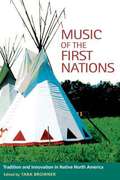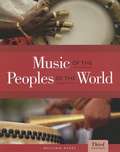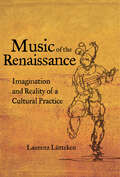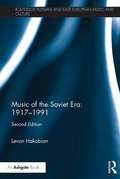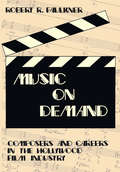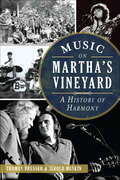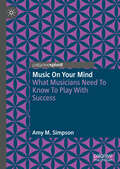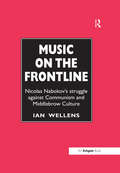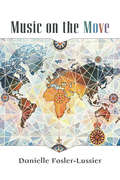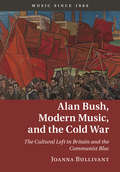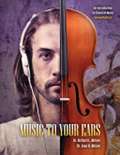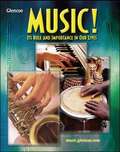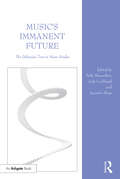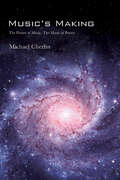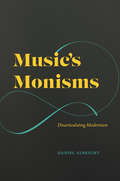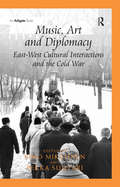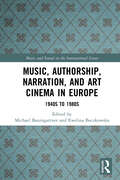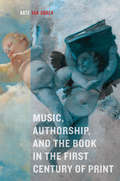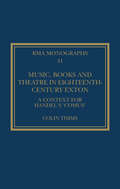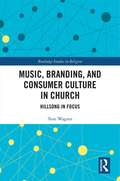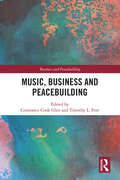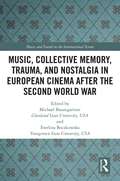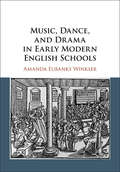- Table View
- List View
Music of the First Nations: Tradition and Innovation in Native North America (Music in American Life)
by Tara BrownerThis unique anthology presents a wide variety of approaches to an ethnomusicology of Inuit and Native North American musical expression. Contributors include Native and non-Native scholars who provide erudite and illuminating perspectives on aboriginal culture, incorporating both traditional practices and contemporary musical influences. Gathering scholarship on a realm of intense interest but little previous publication, this collection promises to revitalize the study of Native music in North America, an area of ethnomusicology that stands to benefit greatly from these scholars' cooperative, community-oriented methods. Contributors are T. Christopher Aplin, Tara Browner, Paula Conlon, David E. Draper, Elaine Keillor, Lucy Lafferty, Franziska von Rosen, David Samuels, Laurel Sercombe, and Judith Vander.
Music of the Peoples of the World (Third Edition)
by William AlvesThis book emphasizes the necessity of understanding music and its culture, and draws on diverse perspectives to guide the student, including music theory, musicology and ethnomusicology.
Music of the Renaissance: Imagination and Reality of a Cultural Practice
by Laurenz LüttekenWhere previous accounts of the Renaissance have not fully acknowledged the role that music played in this decisive period of cultural history, Laurenz Lütteken merges historical music analysis with the analysis of the other arts to provide a richer context for the emergence and evolution of creative cultures across civilizations. This fascinating panorama foregrounds music as a substantial component of the era and considers musical works and practices in a wider cultural-historical context. Among the topics surveyed are music's relationship to antiquity, the position of music within systems of the arts, the emergence of the concept of the musical work, as well as music's relationship to the theory and practice of painting, literature, and architecture. What becomes clear is that the Renaissance gave rise to many musical concepts and practices that persist to this day, whether the figure of the composer, musical institutions, and modes of musical writing and memory.
Music of the Soul: Composing Life Out of Loss (Series in Death, Dying, and Bereavement)
by Joy S. BergerMusic of the Soul guides the reader through principles, techniques, and exercises for incorporating music into grief counseling, with the end goal of further empowering the grieving person. Music has a unique ability to elicit a whole range of powerful emotional responses in people - even so far as altering or enhancing one's mood - as well as physical reactions. This interdisciplinary text draws in equal parts from contemporary grief/loss theory, music therapy research, historical examples of powerful music, case studies, and both self-reflecting and teaching exercises. Music is as much about beginnings as endings, and thus the book moves through life’s losses into its new beginnings, using musical expression to help the bereaved find meaning in loss and hurt, and move forward with their lives. With numerous exercises and examples for implementing the use of music in grief counseling, the book offers a practical and flexible approach to a broad spectrum of mental health practitioners, from thanatologists to hospice staff, at all levels of professional training and settings.
Music of the Soviet Era: 2nd Edition (Routledge Russian and East European Music and Culture)
by Levon HakobianThis volume is a comprehensive and detailed survey of music and musical life of the entire Soviet era, from 1917 to 1991, which takes into account the extensive body of scholarly literature in Russian and other major European languages. In this considerably updated and revised edition of his 1998 publication, Hakobian traces the strikingly dramatic development of the music created by outstanding and less well-known, ‘modernist’ and ‘conservative’, ‘nationalist’ and ‘cosmopolitan’ composers of the Soviet era. The book’s three parts explore, respectively, the musical trends of the 1920s, music and musical life under Stalin, and the so-called ’Bronze Age’ of Soviet music after Stalin’s death. Music of the Soviet Era: 1917–1991 considers the privileged position of music in the USSR in comparison to the written and visual arts. Through his examination of the history of the arts in the Soviet state, Hakobian’s work celebrates the human spirit’s wonderful capacity to derive advantage even from the most inauspicious conditions.
Music on Demand: Composers and Careers in the Hollywood Film Industry
by Robert R. FaulknerIn this remarkable study, Robert R. Faulkner shows that the Hollywood film industry, like most work communities, is dominated by a highly productive and visible elite who exercise major influence on the control of available resources, career chances, and access to opportunity. Faulkner traces a network of connections that bind together filmmakers (employers) and composers (employees) and reveals how work is allocated among composers and the division of labor within the Hollywood film community, using statistical analysis and highly revealing personal interviews. One of the very first empirical studies in the ""new economic sociology,"" Music on Demand shows the dynamics of markets constituted by the interaction between buyers and artistic talent (the producers and directors of feature films) and the sellers of artistic talent (the composers of film scores).Faulkner's interviews with those composers considered to be elite and those on the industry's periphery reveal how they perceive their careers, how they define commercial artistic success, and how they establish, or try to establish, those vital connections with filmmakers. Now available in paperback, this pioneering study will be of compelling interest to researchers in culture studies as well as readers interested in learning more about this little-known world.
Music on Martha's Vineyard: A History of Harmony (Music Ser.)
by Thomas Dresser Jerold MuskinMartha's Vineyard has a rich musical legacy that stretches back to the earliest drumbeats of the Wampanoags and the whaling chanteys of the nineteenth century. Returning Civil War veterans formed the island's oldest continuous music ensemble, the Vineyard Haven Band. Vineyarders embrace all things musical, from choral and string ensembles to singers and songwriters. Discover this melodious history from the early twentieth-century dance bands at the Tivoli ballroom, through the war years, the piano bars and the nascent folk music scene at the Mooncusser Cafe, where Carly Simon and James Taylor played their first licks. Authors Thomas Dresser and Jerry Muskin explore the homegrown music scene and the summer stars who keep islanders and visitors moving to the beat.
Music on Your Mind: What Musicians Need to Know to Play with Success
by Amy M. SimpsonThis book provides musicians, students, and teachers a practical guide for optimal music learning, practice, memorization, and performance by the application of modern neuro-music research. Uncover the best, scientifically researched techniques, supported by researchers and musicians alike, that will empower you to learn thoroughly, practice optimally, and perform at your best. Do you know how people learn? Do you know how people improve motor-skills for playing an instrument? Do you know how to focus attention and stay motivated? Discover the essential answers you need to revitalize and optimize your daily work as a musician. By applying the best methods and knowing why they work, you, too, can create successful practice routines with positive, rewarding, results. Know the best techniques for preparing expert music performance. Learn how to play with success!
Music on the Frontline: Nicolas Nabokov's Struggle Against Communism and Middlebrow Culture
by Ian WellensThe story of Nicolas Nabokov's involvement with the CIA-funded Congress for Cultural Freedom (CCF) is a story of the politics and sociology of culture; how music was used for political ends and how intellectual groups formed and functioned during the Cold War. The seemingly independent CCF, established to counteract apparent Soviet successes in the fields of the arts and intellectual life, appointed Nabokov (a Russian emigre and minor composer) as its Secretary General in 1951.Over the next ten years he gave music a high profile in the work of the organisation, producing four international musical festivals, the first and most ambitious of which was 1952's L'Oeuvre du XXe siècle in Paris, an event which showcased the work of no less than 62 composers. As Ian Wellens reveals, Nabokov's musical involvement with the CCF was in fact a struggle on two fronts.Apparently a defence of Western modernism against 'backward', 'provincial' Soviet music, Nabokov's writings show this to have meshed closely with the domestic concern- shared by many intellectuals -that high culture was being undermined by an increasingly culturally aware middle class. His attacks on Soviet cultural policy, and his unflattering assessments of Shostakovich, are seen to be not merely salvos in the cold war but part of a broader campaign aimed at securing the authority and prestige of intellectuals.
Music on the Move
by Danielle Fosler-LussierMusic is a mobile art. When people move to faraway places, whether by choice or by force, they bring their music along. Music creates a meaningful point of contact for individuals and for groups; it can encourage curiosity and foster understanding; and it can preserve a sense of identity and comfort in an unfamiliar or hostile environment. As music crosses cultural, linguistic, and political boundaries, it continually changes. While human mobility and mediation have always shaped music-making, our current era of digital connectedness introduces new creative opportunities and inspiration even as it extends concerns about issues such as copyright infringement and cultural appropriation. With its innovative multimodal approach, Music on the Move invites readers to listen and engage with many different types of music as they read. The text introduces a variety of concepts related to music’s travels—with or without its makers—including colonialism, migration, diaspora, mediation, propaganda, copyright, and hybridity. The case studies represent a variety of musical genres and styles, Western and non-Western, concert music, traditional music, and popular music. Highly accessible, jargon-free, and media-rich, Music on the Move is suitable for students as well as general-interest readers.
Music since 1900: The Cultural Left in Britain and the Communist Bloc (Music since 1900)
by Joanna BullivantThe first major study of Alan Bush, this book provides new perspectives on twentieth-century music and communism. British communist, composer of politicised works, and friend of Soviet musicians, Bush proved to be 'a lightning rod' in the national musical culture. His radical vision for British music prompted serious reflections on aesthetics and the rights of artists to private political opinions, as well as influencing the development of state-sponsored music making in East Germany. Rejecting previous characterisations of Bush as political and musical Other, Joanna Bullivant traces his aesthetic project from its origins in the 1920s to its collapse in the 1970s, incorporating discussion of modernism, political song, music theory, opera, and Bush's response to the Soviet music crisis of 1948. Drawing on a wealth of archival sources, including recently released documents from MI5, this book constructs new perspectives on the 'cultural Cold War' through the lens of the individual artist.
Music to Our Ears (Fountas & Pinnell LLI Purple #Level R)
by Jack SilbertText Elements <p> Genre: Expository <p> Text Structures <p> Main: Chronological Sequence <p> Embedded: Categorical, Compare/ Contrast, Cause/Effect <p> Text Features: table of contents, headings, sidebars, glossary
Music to Your Ears: An Introduction to Classical Music
by Richard L Mcgee Joan B McgeeMusic to Your Ears: An Introduction to Classical Music
Music! Its Role and Importance in Our Lives
by George Degraffenreid Charles Fowler Timothy Gerber Vincent LawrenceMusic! Its Role and Importance In Our Lives is focused upon the use and value of music in people's lives. It encourages students to view music in a social context rather than as abstract information to be learned for its own sake. It presents music as a natural and essential ingredient of one's own life and of human life in all cultures. This book was written for all students, not just those who sing in the chorus or play in the band or orchestra.
Music's Immanent Future: The Deleuzian Turn in Music Studies
by Jennifer Shaw Sally Macarthur Judy LochheadThe conversations generated by the chapters in Music's Immanent Future grapple with some of music's paradoxes: that music of the Western art canon is viewed as timeless and universal while other kinds of music are seen as transitory and ephemeral; that in order to make sense of music we need descriptive language; that to open up the new in music we need to revisit the old; that to arrive at a figuration of music itself we need to posit its starting point in noise; that in order to justify our creative compositional works as research, we need to find critical languages and theoretical frameworks with which to discuss them; or that despite being an auditory system, we are compelled to resort to the visual metaphor as a way of thinking about musical sounds. Drawn to musical sound as a powerful form of non-verbal communication, the authors include musicologists, philosophers, music theorists, ethnomusicologists and composers. The chapters in this volume investigate and ask fundamental questions about how we think, converse, write about, compose, listen to and analyse music. The work is informed by the philosophy primarily of Gilles Deleuze and Felix Guattari, and secondarily of Michel Foucault, Julia Kristeva and Jean-Luc Nancy. The chapters cover a wide range of topics focused on twentieth and twenty-first century musics, covering popular musics, art music, acousmatic music and electro-acoustic musics, and including music analysis, music's ontology, the noise/music dichotomy, intertextuality and music, listening, ethnography and the current state of music studies. The authors discuss their philosophical perspectives and methodologies of practice-led research, including their own creative work as a form of research. Music's Immanent Future brings together empirical, cultural, philosophical and creative approaches that will be of interest to musicologists, composers, music analysts and music philosophers.
Music's Making: The Poetry of Music, the Music of Poetry
by Michael CherlinAs a work of musical theory, or meta-theory, Music's Making draws extensively on work done in philosophy and literary criticism in addition to the scholarship of musicologists and music theorists. Music's Making is divided into two large parts. The first half develops global attitudes toward music: emergence out of self and hearing through (drawing on Kabbalah and other sources), middle-voice (as discussed in philosophical phenomenology), liminal space (as discussed in literary theory), an ethics of intersubjectivity (drawing on Levinas), and character, canon, and metaleptic transformations (drawing chiefly on Harold Bloom). The second half embodies a search for metaphors, figurative language toward understanding music's endlessly variegated shaping of time-space. The musicians and scholars who inform this part of the book include Pierre Boulez, Gilles Deleuze, Anton Webern, Morton Feldman, and James Dillon. The book closes with an extended inquiry into the metaphors of horizontal and vertical experience and the spiritual qualities of musical experience expressed through those metaphors.
Music's Monisms: Disarticulating Modernism
by Daniel AlbrightDaniel Albright investigates musical phenomena through the lens of monism, the philosophical belief that things that appear to be two are actually one. Daniel Albright was one of the preeminent scholars of musical and literary modernism, leaving behind a rich body of work before his untimely passing. In Music’s Monisms, he shows how musical and literary phenomena alike can be fruitfully investigated through the lens of monism, a philosophical conviction that does away with the binary structures we use to make sense of reality. Albright shows that despite music’s many binaries—diatonic vs. chromatic, major vs. minor, tonal vs. atonal—there is always a larger system at work that aims to reconcile tension and resolve conflict. Albright identifies a “radical monism” in the work of modernist poets such as T. S. Eliot and musical works by Wagner, Debussy, Britten, Schoenberg, and Stravinsky. Radical monism insists on the interchangeability, even the sameness, of the basic dichotomies that govern our thinking and modes of organizing the universe. Through a series of close readings of musical and literary works, Albright advances powerful philosophical arguments that not only shed light on these specific figures but also on aesthetic experience in general. Music’s Monisms is a revelatory work by one of modernist studies’ most distinguished figures.
Music, Art and Diplomacy: East-west Cultural Interactions And The Cold War
by Simo Mikkonen Pekka SuutariMusic, Art and Diplomacy shows how a vibrant field of cultural exchange between East and West was taking place during the Cold War, which contrasts with the orthodox understanding of two divided and antithetical blocs. The series of case studies on cultural exchanges, focusing on the decades following the Second World War, cover episodes involving art, classical music, theatre, dance and film. Despite the fluctuating fortunes of diplomatic relations between East and West, there was a continuous circulation of cultural producers and products. Contributors explore the interaction of arts and politics, the role of the arts in diplomacy and the part the arts played in the development of the Cold War. Art has always shunned political borders, wavering between the guidance of individual and governmental patrons, and borderless expression. While this volume provides insight into how political players tried to harness the arts to serve their own political purposes, at the same time it is clear that the arts and artists exploited the Cold War framework to reach their own individual and professional objectives. Utilizing archives available only since the collapse of the Soviet Union, the volume provides a valuable socio-cultural approach to understanding the Cold War and cultural diplomacy.
Music, Authorship, Narration, and Art Cinema in Europe: 1940s to 1980s (Music and Sound on the International Screen)
by Michael Baumgartner Ewelina BoczkowskaMusic, Authorship, Narration, and Art Cinema in Europe: 1940s to 1980s investigates the function of music in European cinema after the Second World War up to the fall of the Berlin wall, a period when composers and directors embraced experimentation. Through analyses of music and sound in a wide range of iconic films from across Europe, the essays in this book provide a nuanced reconsideration of three core themes: auteur theory, art house film, and national cinema. Chapters written by an international array of contributors focus on case studies of music in the cinema of Carlos Saura, Jean-Pierre Melville, the Polish School, and Romanian directors, as well as collaborations between directors and composers, including Michelangelo Antonioni and Giovanni Fusco, Federico Fellini and Nino Rota, Leo Arnshtam and Dmitry Shostakovich, and Peter Greenaway and Michael Nyman. The contributors shift the emphasis from a director-centered view to the working relationship between director and composer, and from the visual component to the sonic aspects of these films, without ignoring the close correlation between soundtrack and visual elements. Enriching our understanding of the complex, intertwined nature of authorship in film, the role of film music, and sound, nation-state and art cinema, and European cinematic history, this volume offers a valuable addition to research across music and film studies.
Music, Authorship, and the Book in the First Century of Print
by Kate Van OrdenWhat does it mean to author a piece of music? What transforms the performance scripts written down by musicians into authored books? In this fascinating cultural history of Western music's adaptation to print, Kate van Orden looks at how musical authorship first developed through the medium of printing. When music printing began in the sixteenth century, publication did not always involve the composer: printers used the names of famous composers to market books that might include little or none of their music. Publishing sacred music could be career-building for a composer, while some types of popular song proved too light to support a reputation in print, no matter how quickly they sold. Van Orden addresses the complexities that arose for music and musicians in the burgeoning cultures of print, concluding that authoring books of polyphony gained only uneven cultural traction across a century in which composers were still first and foremost performers.
Music, Books and Theatre in Eighteenth-Century Exton: A Context for Handel's ‘Comus’ (Royal Musical Association Monographs)
by Colin TimmsThis book establishes the cultural background to the productions of Milton’s Comus that were staged in the 1740s by Baptist Noel, 4th Earl of Gainsborough, at Exton Hall, his country seat in the East Midlands of England. The author reveals that Handel’s visit in 1745 occurred in a richer and fuller context of cultural interests among the Noel family. Most of the music at Exton was selected from existing works by Handel, but the four movements of the finale were new, written by the composer specifically for the occasion. The study is based on receipted bills and other documents in an archival collection of Noel family papers that provide evidence of the Earl’s purchase of books and music and of the musical and theatrical activities undertaken on his Exton estate. The author discusses the Earl’s interests in music, books and theatre, indicating a belief in performance as a valuable and enjoyable experience and as a vehicle for the education of the young. In addition to creating a context for Comus, this book sheds light on cultural life in a mid-eighteenth-century English country house and how the Earl’s productions made a significant contribution to the cultural life of the East Midlands. The book will be of great value to cultural musicologists, historians and Handelians, as the documentation sheds a huge amount of light on a variety of cultural practices in eighteenth-century England.
Music, Branding and Consumer Culture in Church: Hillsong in Focus (Routledge Studies in Religion)
by Tom WagnerStarting as a single congregation in Australia, Hillsong Church now has campuses worldwide, releases worship music that sells millions of albums and its ministers regularly appear in mainstream media. So, how has a single church gained such international prominence? This book offers an ethnographic exploration of the ways in which music and marketing have been utilised in the pursuit and production of spiritual experience for members of Hillsong Church. An experience that has proven to be incredibly popular. The main theme of this book is that marketing, specifically branding, is not just a way to "sell" religion, but rather an integral part of spiritual experience in consumer society. Focussing on the London Hillsong church as a case study, the use of its own music in tandem with strong branding is shown to be a co- and re-productive method of organizing, patterning, and communicating information. The church provides the branded material and cultural context in which participants’ sacred experience of self unfolds. However, this requires participants to "do the work" to properly understand, and ultimately embody, the values associated with the brand. This book raises important questions about the role of branding and music in forming modern scared identities. As such, it will be of great interest to scholars of Religious Studies, Ethnomusicology and Media Studies.
Music, Business and Peacebuilding (Business and Peacebuilding)
by Timothy L. Fort Constance Cook GlenBusiness schools are placing more emphasis on the role of business in society. Top business school accreditors are shifting to mandating that schools teach their students about the social impact of business, including AACSB standards to require the incorporation of business impact on society into all elements of accredited institutions. Researchers are also increasingly focused on issues related to sustainability, but in particular to business and peace as a field. A strong strain of scholarship argues that ethics is nurtured by emotions and through aesthetic quests for moral excellence. The arts (and music as shown specifically in this book) can be a resource to nudge positive emotions in the direction toward ethical behavior and, logically, then toward peace. Business provides a model for positive interactions that not only foster long-term successful business but also incrementally influences society. This book provides an opportunity for integration and recognition of how music (and other art forms) can further encourage business toward the direction of peace while business provides a platform for the dissemination and modeling of the positive capabilities of music toward the aims of peace in the world today. The primary market for this book is the academic audience. Unlike many other academic books, however, the interdisciplinary nature of the book allows for multiple academic audiences. Thus, this book reaches into schools of music, business, political science, film studies, sports and society studies, the humanities, ethics and, of course, peace studies.
Music, Collective Memory, Trauma and Nostalgia in European Cinema after the Second World War (Music and Sound on the International Screen)
by Michael Baumgartner Ewelina BoczkowskaIn the wake of World War II, the arts and culture of Europe became a site where the devastating events of the 20th century were remembered and understood. Exploring one of the most integral elements of the cinematic experience—music—the essays in this volume consider the numerous ways in which post-war European cinema dealt with memory, trauma and nostalgia, showing how the music of these films shaped the representation of the past. The contributors consider films from the United Kingdom, Poland, the Soviet Union, France, Italy, Germany, and the Netherlands, providing a diverse and well-rounded understanding of film music in the context of historical memory. Memory is often underrepresented within scholarly musical studies, with most of these applications found in the disciplines of ethnomusicology, popular music studies, music cognition, and psychology and music therapy. Likewise, trauma has mainly been studied in relation to music in only a few historical contexts, while nostalgia has attracted even less academic attention. In three parts, this volume addresses each area of study as it relates to the music of European cinema from 1945 to 1989, applying an interdisciplinary approach to investigate how films use music to negotiate the precarious relationships we maintain with the past. Music, Collective Memory, Trauma and Nostalgia in European Cinema after the Second World War offers compelling arguments as to what makes music such a powerful medium for memory, trauma and nostalgia.
Music, Dance, and Drama in Early Modern English Schools
by Amanda Eubanks WinklerMusic, Dance, and Drama in Early Modern English Schools is the first book to systematically analyze the role that the performing arts played in English schools after the Reformation. Although the material record is riddled with gaps, Amanda Eubanks Winkler sheds light on the subject through an innovative methodology that combines rigorous archival research with phenomenological and performance studies approaches. She organizes her study around a series of performance-based questions that demonstrate how the schoolroom intersected with the church, the court, the domicile, the concert room, and the professional theater, which allows her to provide fresh perspectives on well-known canonical operas performed by children, as well as lesser-known works. Eubanks Winkler also interrogates the notion that performance is ephemeral, as she considers how scores and playtexts serve as a conduit between past and present, and demonstrates the ways in which pedagogical performance is passed down through embodied praxis.
